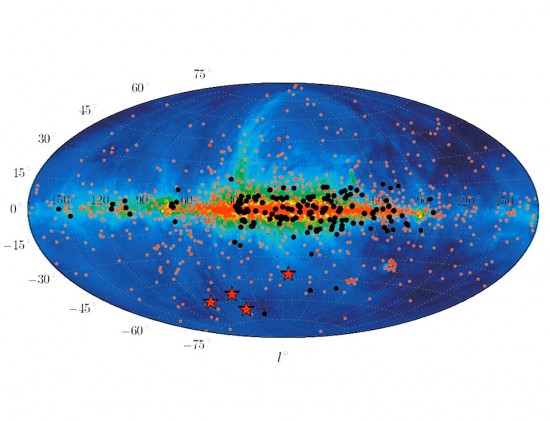Apr 25, 2014
Radio bursts from intergalactic space.
Several Picture of the Day articles address the problems with Gamma Ray Bursters (GRB). GRBs are said to be incredibly powerful electromagnetic emissions generated by neutron star collisions, supernova explosions, or black hole “birth pangs”. The first few GRBs detected by the SWIFT satellite are located in high redshift galaxies: some said to be 12 billion light-years away. If they are that far away, the energies observed are beyond any supernova, so a hypothetical cosmic entity known as a “hypernova” was invoked, salvaging the redshift-indicates-distance theory.
As astrophysicists speculate, hypernovae occur in stars that are many times the mass of the Sun. Due to that extreme mass, conventional theories say that once their fusion cores implode, their intense gravity fields cause them to collapse, forming black holes. The remaining shell of gas and dust rebounds off the collapsing core, forming a hypernova. Irrespective of the process, it is still not known how a hypernova explosion, and the subsequent collapse into a black hole, creates a GRB.
Six years ago, radio astronomers discovered another strange, powerful energy burst: a Fast Radio Burst, or FRB. The power in that first five millisecond event was described as releasing more energy than the Sun puts out in a month. What can cause such a powerful radio signal? Ironically, instead of a black hole’s birth pangs, the FRB was surmised to come from the death of a black hole.
Modern theories about black holes now allow them to “evaporate” through a process known as “Hawking radiation”. According to Stephen Hawking, if a black hole contains M solar masses, a blackbody “glow” of 6 X 10^-8/M Kelvin will exist. This means that an “unfed” black hole should radiate its mass away, eventually exploding like a hydrogen bomb. However, an M solar mass black hole ought to last 10^71(M^3) seconds, so detecting one is “problematic”. Even the astronomers who proposed the idea considered it “speculative”. Instead, the more popular theory relies on the invocation of another hypothetical entity, a “blitzar”.
As a relatively recent announcement from the University of Manchester reports, the discovery of four more FRBs using the 64 meter radio telescope in Parkes, Australia brings the total number to six. A blitzar is supposed to be a neutron star whose mass would ordinarily cause it to collapse into a black hole, but it is spinning so rapidly that its angular momentum prevents that from happening. Since the radio bursts are so powerful and said to be so far away, over 11 billion light-years, the blitzar, or “overweight neutron star”, is necessary (again) in order to save redshift theory.
Redshift is the commonly accepted idea for placing objects in space at their proper distances. Using parallax measurements, the distance to nearby stars is possible to determine, but beyond a few light-years, the angles become so small that they cannot be resolved. Therefore, redshift came into play so that the distance to more remote bodies could be determined.
By way of review, Edwin Hubble, using the 100-inch telescope at Mt. Wilson observatory, believed that he had observed galaxies receding from the Milky Way. The most surprising piece of his recorded data was not the recession itself, but the high velocities associated with his measurements. According to his calculations, some galaxies were traveling away from his observatory at thousands of kilometers per second.
Adapting the Doppler effect (named for the Austrian physicist Christian Doppler, who came up with the idea in 1842) to the spectra of various galaxies, Hubble thought that the change in location of particular elemental signatures called Fraunhofer lines (for the German physicist Joseph von Fraunhofer) indicated that the lightwaves had been shifted toward the red end of the spectrum by an apparent recessional velocity.
Fraunhofer lines are supposed to occur at specific frequencies identified in the spectrum by the kind of element that is absorbing the light. If they are in a different location, they have been Doppler-shifted because of the element’s acceleration. This forms the backbone of galactic-scale distance calculations and the supposed speed of recession that galaxies display. The problems with redshift and their associated resolution by Dr. Halton Arp is not the topic of this paper. Suffice to say, Doppler’s ideas are improperly attributed to stellar distance.
Now, the blitzar is supposed to be a way to salvage that theory because, as the press release about FRBs states, radio waves are slowed by electrons in space, so the conclusion is that the radio signals must have travelled billions of light-years. Therefore, the FRBs “emit as much energy in a few milliseconds as the Sun does in a million years”.
As Electric Universe cosmologists conclude, however, another explanation for FRB intensity is that redshift is not actually an indicator of distance, so they are occurring in nearby galactic neighborhoods. FRBs are not unimaginably powerful, not coming from the edge of a speculative expanding space-time continuum, and are not the death throes of black holes.
If FRBs are actually nearby, they are less energetic, so plasma discharges in the form of exploding double layers could impel them in ways that can be explored though laboratory experiments. Rather than relying on mathematical phantoms like black holes, overweight neutron stars and blitzars, why not create real, testable hypotheses and work them up with real, physical models?
Standard cosmological theories are hard-pressed to match models with observations. Radio waves, X-rays from ion excitation, and a range of energy curves are properties of lightning bolts. Computer simulations demonstrate that plasma phenomena are scalable over several orders of magnitude: they behave in the same way and illustrate basic premises whether in atoms or galaxies. In another ironic twist, the word “blitzar” comes from the German word for lightning. Perhaps FRBs are really flashes of cosmic lightning erupting from electrified clouds of plasma on an immense scale.
Stephen Smith
Click here for a Spanish translation













